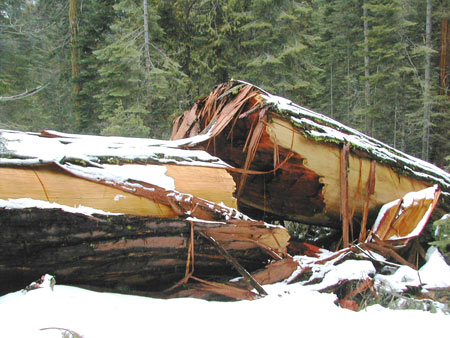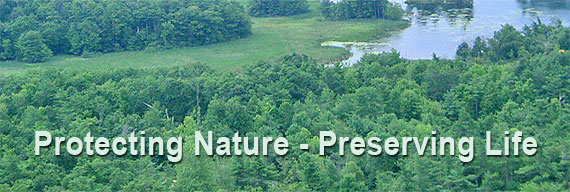Chapter 7
The Big Trees
Part 4
In the course of my studies I observed that
the northern groves, the
only ones I was at first acquainted with, were located on just those
portions of the general forest soil-belt that were first laid bare
toward the close of the glacial period when the ice-sheet began to
break
up into individual glaciers. And while searching the wide basin of the
San Joaquin, and trying to account for the absence of sequoia where
every condition seemed favorable for its growth, it occurred to me that
this remarkable gap in the sequoia belt fifty miles wide is located
exactly in the basin of the vast, ancient mer de glace of the
San
Joaquin and Kings River basins which poured its frozen floods to the
plain through this gap as its channel. I then perceived that the next
great gap in the belt to the northward, forty miles wide, extending
between the Calaveras and Tuolumne groves, occurs in the basin of the
great ancient mer de glace of the Tuolumne and Stanislaus basins; and
that the smaller gap between the Merced and Mariposa groves occurs in
the basin of the smaller glacier of the Merced. The wider the ancient
glacier, the wider the corresponding gap in the sequoia belt.
Finally, pursuing my investigations across
the basins of the Kaweah
and Tule, I discovered that the sequoia belt attained its greatest
development just where, owing to the topographical peculiarities of the
region, the ground had been best protected from the main ice-rivers
that
continued to pour past from the summit fountains long after the smaller
local glaciers had been melted.
Taking now a general view of the belt,
beginning at the south we see
that the majestic ancient glaciers were shed off right and left down
the
valleys of Kern and Kings Rivers by the lofty protective spurs
outspread
embracingly above the warm sequoia-filled basins of the Kaweah and
Tule.
Then, next northward, occurs the wide sequoia-less channel, or basin of
the ancient San Joaquin and sings River mer de glace; then the warm,
protected spots of Fresno and Mariposa groves; then the sequoia-less
channel of the ancient Merced glacier; next the warm, sheltered ground
of the Merced and Tuolumne groves; then the sequoia-less channel of the
grand ancient mer de glace of the Tuolumne and Stanislaus; then the
warm old ground of the Calaveras and Stanislaus groves. It appears,
therefore, that just where, at a certain period in the history of the
Sierra, the glaciers were not, there the sequoia is, and just where the
glaciers were, there the sequoia is not.
But although all the observed phenomena
bearing on the post-glacial
history of this colossal tree point to the conclusion that it never was
more widely distributed on the Sierra since the close of the glacial
epoch; that its present forests are scarcely past prime, if, indeed,
they have reached prime; that the post-glacial day of the species
is probably not half done; yet, when from a wider outlook the vast
antiquity of the genus is considered, and its ancient richness in
species and individuals,--comparing our Sierra Giant and Sequoia
sempervirens of the Coast Range, the only other living species of
sequoia, with the twelve fossil species already discovered and
described
by Heer and Lesquereux, some of which flourished over vast areas in the
Arctic regions and in Europe and our own territories, during tertiary
and cretaceous times--then, indeed, it becomes plain that our two
surviving species, restricted to narrow belts within the limits of
California, are mere remnants of the genus, both as to species and
individuals, and that they may be verging to extinction. But the verge
of a period beginning in cretaceous times may have a breadth of tens of
thousands of years, not to mention the possible existence of conditions
calculated to multiply and re-extend both species and individuals.
There is no absolute limit to the existence
of any tree. Death is due
to
accidents, not, as that of animals, to the wearing out of organs. Only
the leaves die of old age. Their fall is foretold in their structure;
but the leaves are renewed every year, and so also are the essential
organs wood, roots, bark, buds. Most of the Sierra trees die of
disease,
insects, fungi, etc., but nothing hurts the big tree. I never saw one
that was sick or showed the slightest sign of decay. Barring accidents,
it seems to be immortal. It is a curious fact that all the very old
sequoias had lost their heads by lightning strokes. "All things come to
him who waits." But of all living things, sequoia is perhaps the only
one able to wait long enough to make sure of being struck by lightning.
So far as I am able to see at present only
fire and the ax threaten the
existence of these noblest of God's trees. In Nature's keeping they
are safe, but through the agency of man destruction is making rapid
progress, while in the work of protection only a good beginning has
been
made. The Fresno grove, the Tuolumne, Merced and Mariposa groves are
under the protection of the Federal Government in the Yosemite National
Park. So are the General Grant and Sequoia National Parks; the latter,
established twenty-one years ago, has an area of 240 square miles and
is
efficiently guarded by a troop of cavalry under the direction of the
Secretary of the Interior; so also are the small General Grant National
Park, estatblished at the same time with an area of four square miles,
and the Mariposa grove, about the same size and the small Merced and
Tuolumne group. Perhaps more than half of all the big trees have been
thoughtlessly sold and are now in the hands of speculators and mill
men.
It appears, therefore, that far the largest and important section of
protected big trees is in the great Sequoia National Park, now easily
accessible by rail to Lemon Cove and thence by a good stage road into
the giant forest of the Kaweah and thence by rail to other parts of the
park; but large as it is it should be made much larger. Its natural
eastern boundary is the High Sierra and the northern and southern
boundaries are the Kings and Kern Rivers. Thus could be included
the sublime scenery on the headwaters of these rivers and perhaps
nine-tenths of all the big trees in existence. All private claims
within these bounds should be gradually extinguished by purchase by the
Government. The big tree, leaving all its higher uses out of the count,
is a tree of life to the dwellers of the plain dependent on irrigation,
a never-failing spring, sending living waters to the lowland. For every
grove cut down a stream is dried up. Therefore all California is
crying,
"Save the trees of the fountains." Nor, judging by the signs of the
times, is it likely that the cry will cease until the salvation of all
that is left of Sequoia gigantea is made sure.

|













